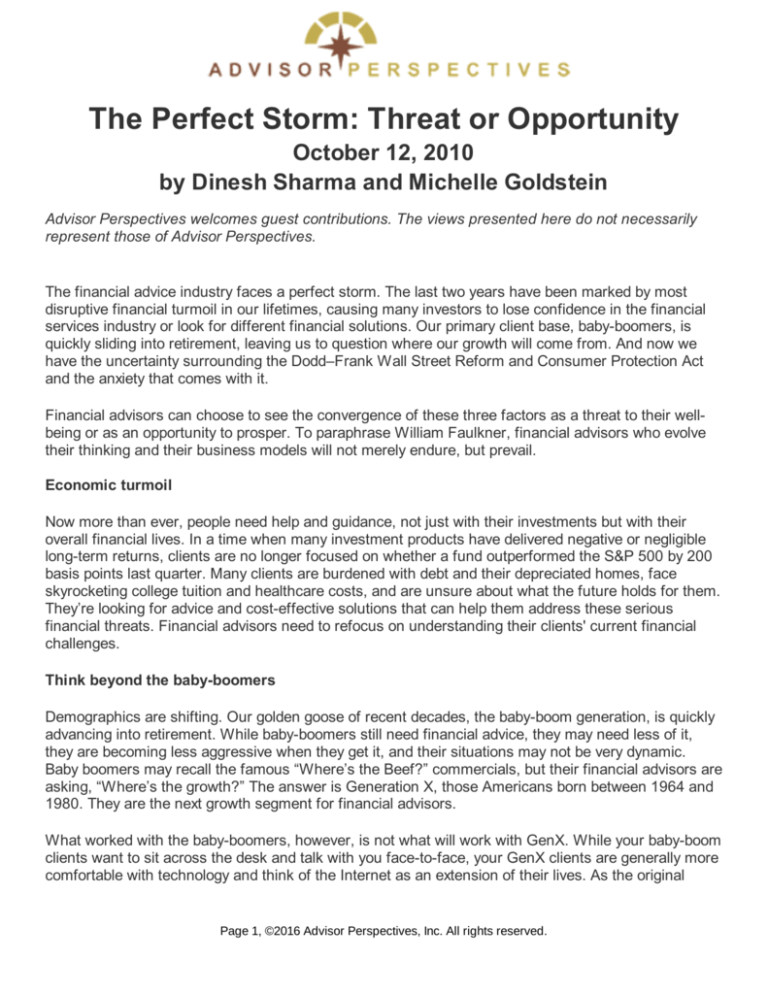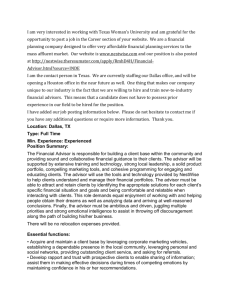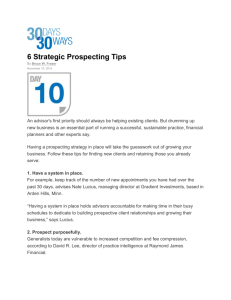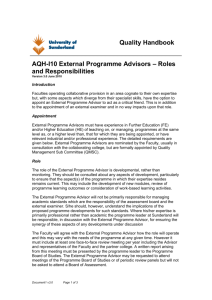
The Perfect Storm: Threat or Opportunity
October 12, 2010
by Dinesh Sharma and Michelle Goldstein
Advisor Perspectives welcomes guest contributions. The views presented here do not necessarily
represent those of Advisor Perspectives.
The financial advice industry faces a perfect storm. The last two years have been marked by most
disruptive financial turmoil in our lifetimes, causing many investors to lose confidence in the financial
services industry or look for different financial solutions. Our primary client base, baby-boomers, is
quickly sliding into retirement, leaving us to question where our growth will come from. And now we
have the uncertainty surrounding the Dodd–Frank Wall Street Reform and Consumer Protection Act
and the anxiety that comes with it.
Financial advisors can choose to see the convergence of these three factors as a threat to their wellbeing or as an opportunity to prosper. To paraphrase William Faulkner, financial advisors who evolve
their thinking and their business models will not merely endure, but prevail.
Economic turmoil
Now more than ever, people need help and guidance, not just with their investments but with their
overall financial lives. In a time when many investment products have delivered negative or negligible
long-term returns, clients are no longer focused on whether a fund outperformed the S&P 500 by 200
basis points last quarter. Many clients are burdened with debt and their depreciated homes, face
skyrocketing college tuition and healthcare costs, and are unsure about what the future holds for them.
They’re looking for advice and cost-effective solutions that can help them address these serious
financial threats. Financial advisors need to refocus on understanding their clients' current financial
challenges.
Think beyond the baby-boomers
Demographics are shifting. Our golden goose of recent decades, the baby-boom generation, is quickly
advancing into retirement. While baby-boomers still need financial advice, they may need less of it,
they are becoming less aggressive when they get it, and their situations may not be very dynamic.
Baby boomers may recall the famous “Where’s the Beef?” commercials, but their financial advisors are
asking, “Where’s the growth?” The answer is Generation X, those Americans born between 1964 and
1980. They are the next growth segment for financial advisors.
What worked with the baby-boomers, however, is not what will work with GenX. While your baby-boom
clients want to sit across the desk and talk with you face-to-face, your GenX clients are generally more
comfortable with technology and think of the Internet as an extension of their lives. As the original
Page 1, ©2016 Advisor Perspectives, Inc. All rights reserved.
latchkey kids, they are self-reliant and tend to be risk takers.
Generation X offers a particularly attractive opportunity for brokers and asset managers. They may not
yet have a lot of investable assets, but they are in growth phase of their lives. At first glance, they may
not seem very attractive to advisors, because they do many things on their own. Many may be willing to
use technology to enter personal data, plan for their financial goals, and play with different what-if
scenarios. They do not necessarily need the advisor for education and awareness, but they still need
advice and guidance on financial decisions.
Dodd-Frank: Seize the opportunity
The SEC is troubled by the differences in regulatory and fiduciary standards between brokers and
advisors. Chair Mary Shapiro said that the SEC seeks to “write rules that would create a uniform
standard of conduct for professionals who provide personalized investment advice to retail customers,”
foreshadowing establishment of a fiduciary standard under which advisors must understand their
clients’ current situations and future needs and goals in greater depth than ever before. For advisors
that get out ahead of this standard, Dodd-Frank presents a tremendous opportunity.
Advice providers — whether fee-based or commission-based — who take advantage of this opportunity
will be those that can best put their clients’ interests first. Obviously, this requires more than simply
asking how your client feels about investments or their financial future. It demands a thorough
assessment of each client's financial situation — the client’s assets, liabilities, income, expenses,
values, beliefs, and overall lifestyle. This suitability analysis is the critical first step of financial planning,
and it doesn't need to be overly complicated.
Financial planning should be like visiting the doctor. The physician gets a detailed health history and
then orders a series of diagnostic tests. Based on the results of those tests, the doctor prescribes a
course of action designed to address the problem. As the treatment is administered, the physician
monitors the patient’s progress. So why do financial advisors’ processes rarely follow this medical
model? There are several reasons, and they all revolve around the financial advisors' business models
and the technologies they use.
Historically, the financial services industry has been built around products; you come with an
interesting product, then figure out ways to sell it to the public. It is easier and less time-consuming
simply to sell a product to a customer than to perform a detailed customer diagnostic in order to figure
out what to sell, how much to sell, or even in some cases to determine that you should not sell
anything to the customer at all. In addition, the available financial planning technology is complicated; it
takes time to learn and use, and that learning time is time taken away from generating revenue.
Moreover, in the past consumers were less willing to pay for financial planning service separately and
more comfortable in paying indirectly. But that is changing now.
The growth of fee-based advice is proof that fee-based advisors have done a good job in educating
public on advantages of paying fees to get product-independent advice. As a result, many commissionbased businesses have moved into a fee-based model. This does not mean the end of commission-
Page 2, ©2016 Advisor Perspectives, Inc. All rights reserved.
based businesses, however. In fact, the new fiduciary requirements of Dodd-Frank may spur
commission-based advisors to reposition their businesses to a model that allows them to better
understand their clients’ needs and serve them more cost-effectively.
Advisors who apply the standards of prudence, attention, and objectivity toward addressing their
clients’ challenges will be well positioned to thrive in a new economic and regulatory environment.
Collaborate with your client
What are your client’s values and beliefs? What are his or her short- and long-term financial goals?
What are your client’s financial threats and opportunities? Engage your client in the process of
developing the right financial plan. As you expand into the GenX market, leverage your clients’ interest
in technology to share some of the work load with them. Provide them tools that help them assess their
financial health and their financial trouble spots, then redirect the time you save into helping them
make financial decisions and into serving more clients. A more informed client will be a more engaged
client too.
These activities increase the client’s confidence and help build a trust-based relationship. Your
investment is time with the client instead of time crunching numbers into a program. Those financial
advisors who will step up to this challenge will win the lasting loyalty of their clients.
Serving your clients like this requires stepping back and taking a careful look at your overall business
model. Your revenues are likely down. You probably have a smaller support staff. But still you need to
invest more time getting to know and understand your clients, and you need to evaluate the business
processes you use to service them.
A collaborative process like this serves everyone well and can ensure that financial advisors succeed
— for their clients, in their businesses, and under the looming requirements of Dodd-Frank. It is true
that collaboration to this extent requires substantial improvements to financial planning technology, but
technology providers are adept at recognizing changing business landscapes and adapting their
technologies to meet evolving needs.
This perfect storm might threaten the prosperity or even the existence of some financial advice
providers. But those who see the prevailing winds beforehand and seize control of the rudder will
prevail. Those advisors will simultaneously serve clients more effectively by better understanding them
and lower their cost structures through more effective, easy-to-use technologies. They will develop
deeper, more trust-based relationships with their clients. They will also more effectively meet the
obligations of a fiduciary.
When the storm passes, they’ll be ready. Will you?
Dinesh Sharma, CFP® and Michelle Goldstein, MBA are part of Omyen Corp., which provides a
lifetime collaborative financial planning platform for investment advisors and clients. They can be
Page 3, ©2016 Advisor Perspectives, Inc. All rights reserved.
reached at and , respectively.
Page 4, ©2016 Advisor Perspectives, Inc. All rights reserved.







